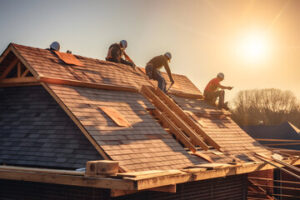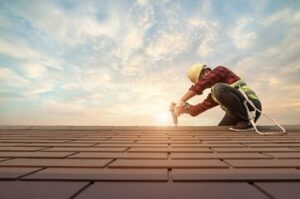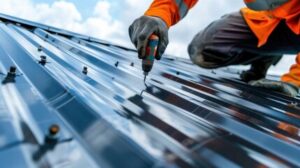If you’re a homeowner looking to install or re-roof your home, you have many choices. An expert roofing team can help you select a material that suits your goals, architecture, and budget.

They’ll start by protecting the eaves with drip edge flashing and ice-and-water sheathing. They’ll also add flashing around chimneys, windows, and other joints. Contact EZ Roofing of Flagler County for expert guidance.
Roofing installation costs can vary depending on the roof type and material. Asphalt shingles are cheaper than slate or metal roofs, which can cost up to $2,500 per square (100 SF). Other factors that impact pricing include labor and roofing materials. Reputable contractors provide detailed, transparent quotes that align with industry standards. Some contractors may offer discounts or package deals when you bundle services.
Whether you’re re-roofing or replacing your roof, the project will start with getting your home ready for work. Contractors will lay tarps on your yard and patios, cover plants and sculptures, and move vehicles off paved areas to prevent damage during the project. They’ll also set up a dumpster and sweep debris off your property before starting the actual work.
When the time comes to install new shingles, the crew will remove the old roof’s surface and make necessary repairs to the deck or structure. Then, they’ll install the new shingles. You can choose from a variety of shingle styles, colors, and thicknesses to create the ideal look for your house.
The cost of installing a new roof will depend on the type and material you select, as well as the size and complexity of your home’s structure. It’s important to speak with a professional roofer to get an accurate estimate for your roofing project.
Adding a layer of shingles to your existing roof is called “reroofing.” While this can save you money, it can reduce the lifespan of your roof. Most cities limit roof layers to two, so if your current shingles are nearing the end of their life, you’ll need to have them removed before you re-roof. The re-roofing process typically includes new underlayment and flashing, which are installed in areas prone to leaks, such as valleys or chimneys.
Materials
There are many roofing materials and designs available, so it’s important to choose the right ones for your project. A qualified roofer can recommend the best options based on your home’s climate and weather patterns, your budget, and aesthetic preferences. For instance, if you’re looking for energy-efficient features, you can ask your roofer about reflective shingles and other eco-friendly additions. You can also upgrade your roof to include solar panels or other renewable energy solutions.
The basic materials used in roofing installation include shingles, sheathing, underlayment, and flashing. The sheathing is the wood base layer that provides a sturdy foundation for other roofing materials. It’s usually made of plywood or oriented strand board (OSB), but older homes may have tongue-and-groove or narrow 1-by-skip sheathing boards of sawn lumber.
Underlayment is a waterproofing membrane installed under the sheathing to help prevent leaks. It’s typically a self-adhesive membrane that helps reduce the need for seams, which are prone to leaks. It’s especially helpful in vulnerable areas of the roof like valleys and eaves, as well as around chimneys, vents, and skylights.
Flashing is a thin metal piece used to reinforce vulnerable areas and enhance roof waterproofing. It’s commonly installed at the edges of the roof, around protrusions such as chimneys, vents, and skylights, and in open valleys where there isn’t any shingle coverage. It can also be used to cover gaps in the sheathing or shingles.
Other important roofing materials include ridge and soffit vents, which promote airflow to prevent moisture build-up in the attic space. Gutters, which collect and divert rainwater to prevent water damage to the fascia and soffit, are another essential component of your roof.
Specialty shingles are available for hip and ridge areas of the roof to provide added protection and a finished look. Other add-ons include a drip edge, which directs rainwater away from the edges of the roof and into gutters. Other systems, such as ridge vents and attic fans, ensure adequate ventilation to prevent heat and moisture build-up in the attic space and reduce the risk of mold growth and other roofing problems.
Time
The time needed to complete a roof replacement depends on a number of factors. Some of the most important are weather and the size of the building. If the job is being done on a commercial or high-rise building, it can take longer than a residential roof.
Another factor is the roofing company’s workload. It may be busier during the summer, which can delay the completion of your roof replacement. It’s best to schedule a roof replacement for fall or early winter. This is when weather is more likely to be clear and sunny. It’s also less busy for roofing contractors, so you might be able to get your work done sooner.
Before the roofing crew starts working, they’ll need to set up some protective measures on your property. They’ll lay tarps around the base of your home to keep debris from damaging landscaping and other features on your property. They’ll also cover your pool and garage, park a dumpster in the driveway, and sweep away any loose debris from the ground.
It’s also a good idea to remove wall decor from your home ahead of time. The vibrations from hammering can knock items off of walls, so it’s best to move mirrors, pictures, wreaths, and loose shelving into the garage or elsewhere before the roofers arrive.
Safety
Safety is one of the most important aspects of any roofing project. Whether homeowners are looking for affordable roofing solutions or roof leak repair, it is vital that they work with contractors who take the necessary precautions to ensure their safety. There are many ways to ensure that roofing projects are safe, including proper training, personal protective equipment (PPE), and adequate liability insurance.
Roofing is a physically demanding job that requires strength and stamina. The physical toll of carrying materials, climbing ladders, and working in all types of weather can lead to aches, pains, and even more serious injuries. It is important for contractors to follow national safety standards and use the right tools for the job to minimize the risk of injury.
PPE should include helmets, harnesses, and gloves. It is also a good idea to bring a worker on the roof who is dedicated to monitoring safety and making sure workers are following proper practices. It is also essential to keep the area clean and free of trip hazards, such as loose or fallen debris.
Another key aspect of safety is properly using ladders and roofing tools. Ladders should be checked for damage on a regular basis and only be used for their intended purpose. Workers should also avoid using nail guns while on the roof and be aware of the potential electrical dangers of standing on ladders near power lines. In addition, it is a good idea to maintain three points of contact on the ladder at all times (two hands and one foot or two feet and one hand).
The weather can have a significant impact on roofing installation, especially in high-rise buildings. It is important to pay close attention to the weather forecast and halt work during adverse conditions. It is also important to have a plan in place for resuming roofing work after bad weather subsides. Putting safety first will not only reduce the risk of injuries, but it will also help the roofing process run smoothly and efficiently.


